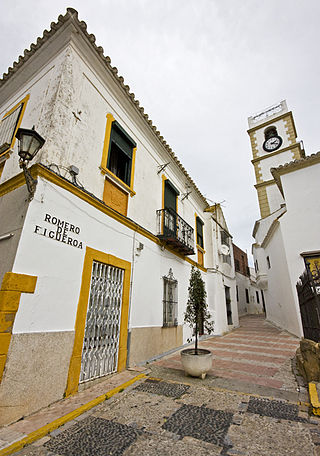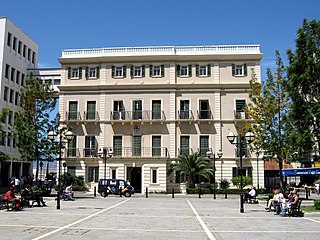The history of Gibraltar portrays how The Rock gained an importance and a reputation far exceeding its size, influencing and shaping the people who came to reside here over the centuries.

Sir Joshua Abraham Hassan, nicknamed "Salvador" (Saviour), was a Gibraltarian politician, and first mayor and Chief Minister of Gibraltar, serving four terms as chief minister for a total of over 20 years. He is seen as the key figure in the civil rights movement in Gibraltar, and played a key role in the creation of the territory's institutions of self-government.

Europa Point, is the southernmost point of Gibraltar. Although not the southernmost point of the Iberian Peninsula, Europa Point defines the boundary between the Straits of Gibraltar in the Atlantic Ocean, and the Alboran Sea within the Mediterranean. At the end of the Rock of Gibraltar, the area is flat and occupied by such features as a playing field and a few buildings. On a clear day, views of North Africa can be seen across the Strait of Gibraltar including Ceuta and the Rif Mountains of Morocco; as well as the Bay of Gibraltar and the Spanish towns along its shores. It is reached from the old town by Europa Road.

The Cathedral of Saint Mary the Crowned is a Latin Catholic cathedral in Gibraltar. It is the primary centre of Catholic worship in the Diocese of Gibraltar.

Our Lady of Lourdes Metropolitan Cathedral, one of the largest churches in Kerala, is located in the heart of Thrissur City in the state of Kerala, India. Dedicated to Our Lady of Lourdes, the Syro-Malabar Catholic church is noted for its imposing interior. The main attraction is an underground shrine, considered a masterpiece of architectural design. Fr John Maliekkal is said to have planned and constructed this church. The exterior of the church features an Indo-European facade with white spires. The centenary of this church was celebrated during the historic visit of Pope John Paul II to Thrissur City in 1986. The cathedral church attracts thousands of pilgrims every month.

The Diocese of Gibraltar is a Latin Church diocese of the Catholic Church in the British overseas territory of Gibraltar. About twenty priests and nine sisters serve in the diocese. Carmelo Zammit was installed as bishop on 24 September 2016. At just over 6 square kilometers, it is among the smallest of all Catholic dioceses in the world.
Bernard Patrick Devlin, KC*HS, CMG, GMH was an Irish clergyman of the Roman Catholic Church. He served as fifth bishop of the Roman Catholic Diocese of Gibraltar from 1985 to 1998.
Albert J. Risso, GMH was a Gibraltarian trade unionist and politician. He was the first president of the Association for the Advancement of Civil Rights (AACR) in Gibraltar.

The Gibraltar Constitution Order 2006 was taken to a referendum in Gibraltar on 30 November 2006. A coalition of groups opposing the proposal held that a majority of 60% should be required to give effect to a new Constitution, quoting other instances, but the political parties held that the result should be decided by a simple majority in favour of the new constitution. The constitution was approved by 60% of the votes anyway.

The Shrine of Our Lady of Europe is a Roman Catholic parish church and national shrine of Gibraltar located at Europa Point. The church is dedicated to Our Lady of Europe, the Catholic patroness of Gibraltar.

Juan Romero de Figueroa was a Spanish Roman Catholic priest, in charge of the Parish Church of St. Mary the Crowned during the last years of Gibraltar's Spanish period and first ones of the British period, until his death. He remained at his post even after the territory's capture by an Anglo-Dutch fleet in 1704 on behalf of the Archduke Charles, one of the claimants to the Spanish throne in the War of the Spanish Succession, when most of its population abandoned Gibraltar.

The Chapel of Our Lady of Europe is a Roman Catholic chapel located in the High Square of Algeciras (Spain). The popularly known "Capillita de Europa" is considered as the foundational element of the modern city of Algeciras. It was the host of the statue of the Virgin and the Child kept in the Shrine of Our Lady of Europe from the capture of Gibraltar by the Anglo-Dutch fleet in 1704 to 1864.
Charles Caruana CBE was a Gibraltarian Roman Catholic bishop of Maltese descent. He was appointed sixth Roman Catholic Bishop of Gibraltar on 14 February 1998 and ordained on 24 May 1998. His retirement request was accepted on 18 March 2010. He died at St Bernard's Hospital, Gibraltar on 1 October 2010 following a bout of ill health.

Our Lady of Europe is a title given to the Blessed Virgin Mary as patroness of Gibraltar and protectress of Europe. The entire European continent was consecrated under the protection of Our Lady of Europe in the early 14th century from the Shrine in Gibraltar where devotion continues to this day, over 700 years on.

The Gibraltar City Hall is the former city hall for Gibraltar, centrally located within the city at the west end of John Mackintosh Square. It is the office of the Mayor of Gibraltar and since 2023 has been the location of the Registry of Marriages.
The Gibraltar-Vatican Joint Issue is a postage stamp that was released by Vatican City and the British Overseas Territory of Gibraltar in 2009. It commemorated the septcentenary of the devotion to Our Lady of Europe. The image on the stamp was a photograph of the statue of the Virgin and Child found in the Shrine of Our Lady of Europe at Europa Point in Gibraltar. The stamp was the first joint issue between Gibraltar and the Vatican.

Edward Rapallo was the third Gibraltarian born Roman Catholic Bishop of Gibraltar following in the footsteps of Bishop Scandella and his successor Bishop Canilla.

Sacred Heart Church is a Catholic church in Gibraltar.

Gonzalo Canilla was a Roman Catholic Bishop and Vicar Apostolic of Gibraltar. There were nearly fifty arrests made to allow Canilla to enter his own church in Gibraltar in 1881.













